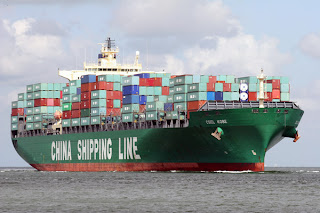Miral Shipping Market Report

BDI to Test June 2009 Highs
Visit the front pages of Wall Street Greek to see our current coverage of economic reports and financial markets.
(Tickers: NYSE: OSG, ISH, SEA, GNK, TNP, DAC, BDI, DSX, NAT, BC, MPX, Nasdaq: TOPS, EGLE, SINO, PRGN, XSEAX, DIA, SPY, QQQQ, NYX, DOG, SDS, QLD, XLF, IWM, TWM, IWD, SDK)
 Since my last report on October 8, the BDI has been firm and in the past two weeks, its increase has intensified. After an over 20% rise last week, the BDI's current momentum suggests that this year's highs, in most vessel categories, will be tested shortly.
Since my last report on October 8, the BDI has been firm and in the past two weeks, its increase has intensified. After an over 20% rise last week, the BDI's current momentum suggests that this year's highs, in most vessel categories, will be tested shortly.Shipping Market Report
As mentioned in my previous reports, government stimulus spending in China and in other major countries has benefited the global dry bulk trade. Several factors that were in play during 2007 and the first half of 2008 that drove the BDI to record levels have re-asserted themselves this year. The rapidly weakening dollar and the associated increasing prices of commodities are an important side-effect of the US government policy of increased spending and assistance to the banking / financial sector. Billions of US dollars have flooded global markets, driving up many asset prices, including the prices of many commodities that are transported in dry bulk vessels.
Very often, these global trends last a long time; longer than many would think. This is also true in the dry bulk shipping market, which relies on the health of global trade. Earlier this year, many (myself included) were skeptical of the duration of this rally, and for good reason. One cannot say that the difficulties in the global economy have been "fixed" within only one year; nor could we have been unconcerned about the amount of new buildings scheduled to enter the market. I'm sure there will be more difficult times ahead, but for now we cannot yet buck the trend – it is for higher freight, and it will remain so until the technical and or fundamental indicators change.
Let's break it down by vessel category:
The Capesize market has been on a tear lately. The Capesize Index stands at 7326; its 4 TC average at 78,075, an increase of nearly 30% in only ten days. We hear reports of increased coal and ore movement in the Atlantic probably destined for Europe; as well as the continued near record imports of ore into China. Port congestion in Chinese ore ports is re-emerging, thus the upward squeeze on Capesize freight.
The Panamax market has run similarly upward, standing at 4091; 4 TC average at 32,879, an approximate 10% increase in the last week. The Panamaxes are participating in the increased coal and ore movements, but there have also been substantial increases in grain transportation from the U.S. Gulf. The weak US dollar has greatly contributed to the reported 30% increase in US exports so far this year, a statistic that is certainly pleasing to US. Government officials and ship-owners alike, as agricultural commodities should make up a large part of this increase.
The Handymax and Handysize freight markets have also increased, but have initially lagged behind the Capesize and Panamax markets. Now they are catching up, with the Handymax index up nearly 5% today alone. The Handysize market was up a little more than 10% in the last week. The US Gulf and India have been particularly active in these vessel segments recently. The Handymax and Handysize Index stand today at 2257 and 985, respectively.
Where do we go from here?
Let's look at the technical clues first. The test for the Capesize market will be if it could surpass the mid US $90,000s 4 TC average. The Panamax market has already surpassed the last resistance point in the high US $20,000s 4 TC average, and the next major resistance is in the low US $40,000s. Handymaxes have also surpassed near-term resistance, and their next test is in the low US $30,000s. Handys are just at near-term resistance, and I would expect them also to follow the larger vessels through. Therefore, it appears as though 20% to over 30% upside now exists in Capes – Handys before new resistance is encountered.
Global macro economic trends appear to have some staying power as well. U.S. government policy is not likely to change at least for the near to possibly medium term. Therefore, the dollar looks to stay weak, and commodity prices elevated. Several government stimuli, China's - of particular importance to dry bulk freight, appear to be in place for a while. India also has needs for a substantial amount of tonnage. Furthermore, the anticipated growth in vessel supply has not yet been realized. Delays and cancellations in new buildings have greatly limited supply growth of new ships, and freights have increased with the rise in vessel demand seen recently. However, a substantial rise in new building deliveries, or decrease in economic stimulus in China and other major economies would end this rally quickly. Stay tuned !!
Editor's Note:
This article should interest shipping market investors in securities including: Overseas Shipholding Group (NYSE: OSG), International Shipholding (NYSE: ISH), Claymore/Delta Global Shipping ETF (NYSE: SEA), Genco Shipping & Trading (NYSE: GNK), Diana Shipping (NYSE: DSX), Danaos (NYSE: DAC), Tsakos Energy Navigation (NYSE: TNP), Nordic American Tanker (NYSE: NAT), Brunswick (NYSE: BC), Marine Products Corp. (NYSE: MPX), Nasdaq: Top Ships (Nasdaq: TOPS), Eagle Bulk Shipping (Nasdaq: EGLE), Sino-Global Shipping (Nasdaq: SINO), Paragon Shipping (Nasdaq: PRGN), Claymore/Delta Global Shipping (Nasdaq: XSEAX).

Please see our disclosures at the Wall Street Greek website and author bio pages found there.

Labels: Miral, Shipping Market











0 Comments:
Post a Comment
<< Home